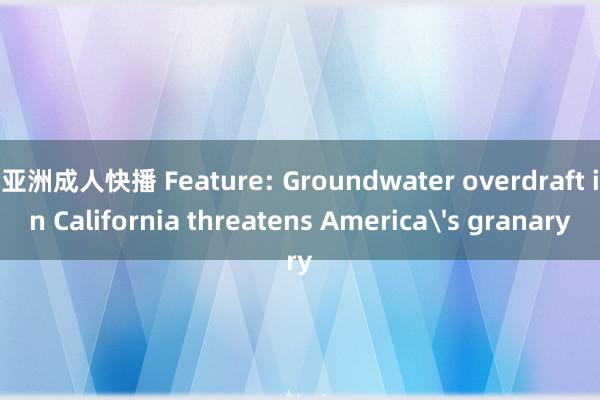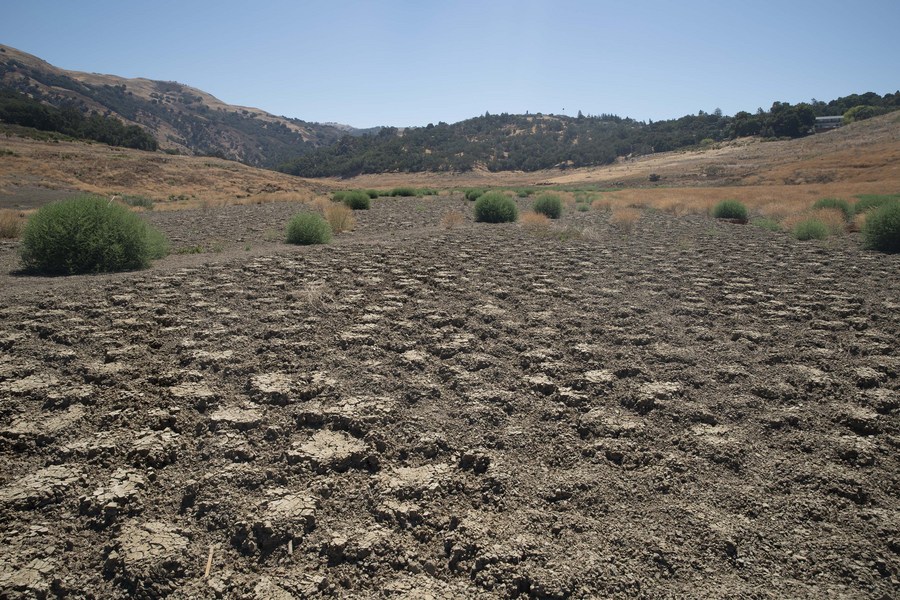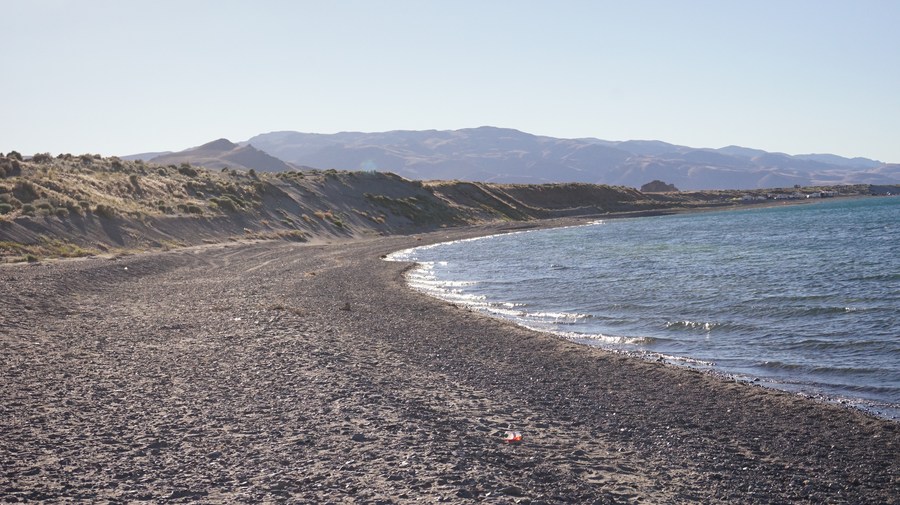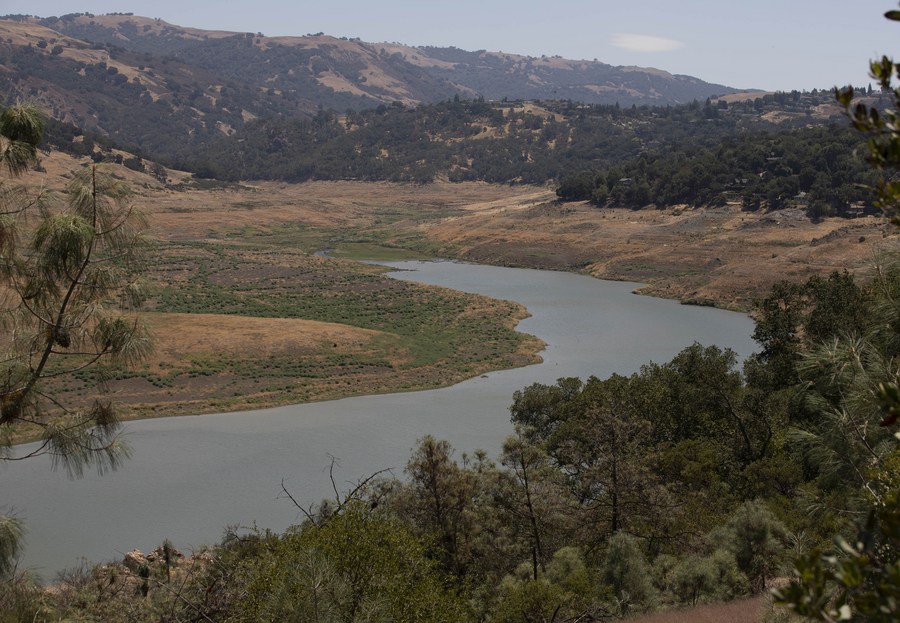

Photo taken on Aug. 8, 2022 shows a view of a dried-up river bed in Morgan Hill of California, the United States. California is in its third consecutive year of severe drought, according to reports. (Photo by Li Jianguo/Xinhua)
U.S. California faces an urgent groundwater crisis due to excessive pumping. It results in dwindling water resources and increased arsenic contamination, posing a significant challenge not only locally, but also nationally. An investigation published by The New York Times said that "America is using up its groundwater like there's no tomorrow."
by Julia Pierrepont III, Cheng Xu
LOS ANGELES, Sept. 2 (Xinhua) -- An urgent groundwater crisis has been escalating in the expansive agricultural region of America's San Joaquin Valley, or called Central Valley in California, and local residents are striving to preserve the country's well of prosperity.
The valley makes up only 1 percent of U.S. farmland, yet it grows 40 percent of the nation's table fruits, vegetables, and nuts annually. Productivity like that is only possible because farmers augment the valley's 5 to 10 inches (12 to 25 centimeters) of annual rainfall with extensive groundwater pumping, which provides more than 80 percent of irrigation water in drought years.
However, after decades of pumping, underground water resources are dwindling. Wells in Central Valley now must be drilled as much as 3,500 feet (over 1,000 meters) deep to find adequate water, a research team from NASA's Jet Propulsion Laboratory in Southern California and the U.S. Department of Energy's Lawrence Berkeley Laboratory in Northern California found in 2022.
Moreover, not only are deep-set private artisan wells depleting the level of water reserves beneath the surface, but what water remains holds a higher concentration of toxic arsenic -- a serious problem for residents who rely on a safe and adequate water supply.
Water management is shaping up to be a nationwide challenge that is particularly acute in California, an investigation published by The New York Times said Wednesday, noting that "America is using up its groundwater like there's no tomorrow."
The investigation called groundwater "a hidden treasure beneath our feet that has historically quenched America's thirst, nourished its farmlands, and supported its booming urban centers" while emphasizing that "especially in arid western regions, this unseen resource has sustained life, urban expansion, and economic growth."
In an average year in California, roughly 40 percent of the state's water supply comes from groundwater亚洲成人快播, and about 85 percent of Californians depend on groundwater for some portion of their water supply, according to the Public Policy Institute of California (PPIC).
Photo taken on July 1, 2022 shows a view of the dried-up water bed at the drought-stricken Pyramid lake, located near California and Nevada border, in Nevada, the United States. (Photo by Zeng Hui/Xinhua)
Yet, this precious legacy may be heading toward depletion. PPIC said in a fact sheet released in 2017 that groundwater overdraft in some agricultural regions averages about 2 million acre-feet annually, while the research of NASA in 2022 found that the San Joaquin Valley is subsiding drastically with current rate of about one foot (0.3 meters) per year.
During the latest drought about twenty years ago, the pace of well drilling increased as farmers and communities sought new sources of water, leading to more than 5,000 domestic wells going dry, said a report from Cal Matters this February, adding that "even in this January, as California's rivers flooded thousands of acres, state officials received reports of more than 30 well outages."
Recent decades have seen the precarious balance of replenishment and extraction disrupted, with pundits listing factors such as climate change, more frequent droughts, industrial pollution, and increased agricultural needs as motives to intensify the strain on groundwater reserves.
Alarmingly, they said the interconnectedness of these water networks meant over-extraction in one locale can compromise water tables many miles away.
Nowhere is this juggling act between nature and necessity more evident than in California. The San Joaquin Valley is still contributing food to the country while a handful of communities there, largely home to low-income Latino residents, have run out of water, forcing people to use bottled water for everything.
The true scope of the problem, in fact, may be underestimated, since many dewatered wells are unreported, the Cal Matters said.
The Anderson Lake is seen with low water level in Morgan Hill of California, the United States, Aug. 8, 2022. California is in its third consecutive year of severe drought, according to reports. (Photo by Li Jianguo/Xinhua)
Tien Tran, an advocate from the Community Water Center, which advocates for water equity, told the press, "There's an overpowering political inertia to maintain extraction rates. It's tied, intricately, to economic incentives, leaving communities grappling for safe water."
Tran admitted candidly, "The political pressure to maintain the status quo and continue extracting water is immense, as it's closely tied to economic profits. Community members cannot rely on wells for safe water."
California introduced the Sustainable Groundwater Management Act about a decade ago to prevent over-extraction, mandating that groundwater agencies implement standardized sustainable management. However, the basins are still over-extracting, with the main groundwater basin in the San Joaquin Valley even being identified as critically over-drafted.
There are encouraging signs that the collective consciousness regarding sustainable water conservation measures is awakening. Across the state, discussions range from building reservoirs to exploring sustainable agricultural practices.
Last August, California Governor Gavin Newsom presented a new water resource strategy, which emphasized an ambitious goal: boosting groundwater replenishment by 500,000 acre-feet yearly.
第四色vvvv88A subsequent related initiative by the state's Department of Water Resources seeks to harness the snowpack from the mountains to replenish state reserves, a move applauded by environmentalists and experts.
To support these legislative measures, local farmers and land stewards empowered by state grants, are constructing vast recharge basins or man-made lakes.
A local farmer, Randy Fiorini, has constructed his own small reservoir to help collect rainwater. "From there, you can meter it into the groundwater basins," he explained to The New York Times.
Places like the Tulare Irrigation District serve as exemplary models, where floodwaters are being channeled into large ponds, where water can seep slowly back into the underlying aquifer to rejuvenate the underground reserves.
Los Angeles County is also tackling this challenge. In 2018, voters passed Measure W, imposing a tax on owners of impermeable surfaces to support stormwater treatment projects.
As climate change looms as the unpredictable variable, Ellen Hanak, a water policy expert, has called for more creative strategies. "Groundwater replenishment亚洲成人快播, though commendable, isn't a standalone solution. With snow melting faster and rain patterns shifting, we need strategies that are both adaptive and swift," he said.


